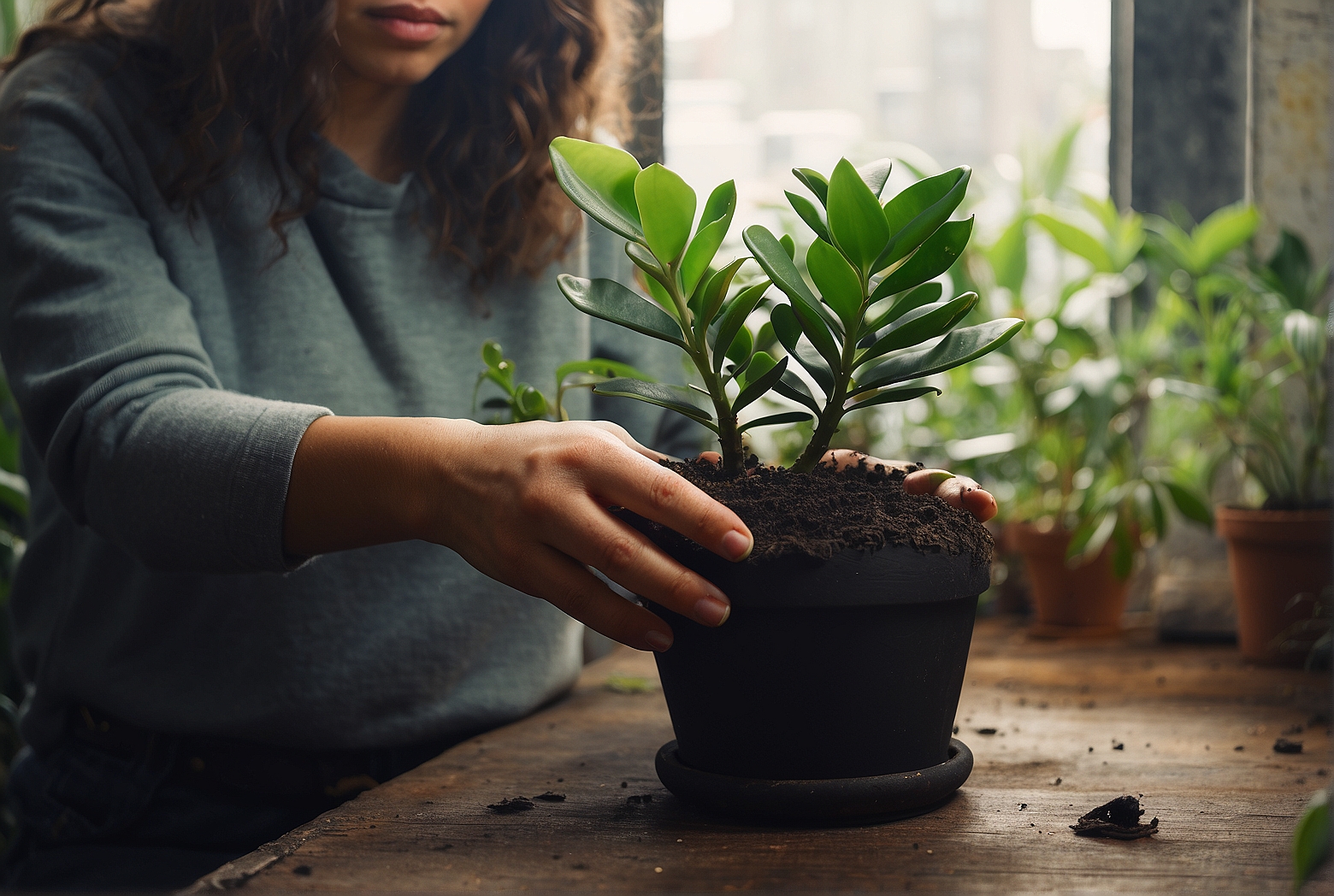Last Updated on April 5, 2024 by Tony Manhart
Have you ever wondered what would happen if you dared to touch a ZZ plant? Well, this captivating article will reveal the surprising consequences that await those who dare to touch this seemingly harmless houseplant. Brace yourself for some unexpected revelations and make sure to keep your hands to yourself when encountering this enchanting but touch-sensitive plant.
Irritation and Allergic Reactions
Skin irritation
One of the potential consequences of touching a ZZ plant is skin irritation. Some people may experience redness, itching, or a rash on their skin when they come into contact with the plant. This can be especially true for individuals with sensitive skin or those who are prone to allergic reactions. It is important to note that not everyone will react to the ZZ plant in the same way, so while one person may have a mild irritation, another person may have a more severe reaction.
Contact dermatitis
Contact dermatitis is another possible outcome of touching a ZZ plant. This condition occurs when your skin comes into contact with an irritating substance, in this case, the sap or the leaves of the plant. Contact dermatitis can cause redness, swelling, and a rash that may be itchy or painful. It is a type of allergic reaction that can occur within hours or even days after contact with the plant. If you suspect you have contact dermatitis from touching a ZZ plant, it is best to consult a dermatologist for proper diagnosis and treatment.
Allergic reactions
In some cases, touching a ZZ plant can trigger allergic reactions in individuals who are specifically allergic to the plant’s components. These allergic reactions can range from mild symptoms such as sneezing or a runny nose to more severe reactions like hives, difficulty breathing, or even anaphylaxis. If you have a known allergy to ZZ plants or any other similar plants, it is essential to avoid touching or coming into contact with them to prevent allergic reactions.

Toxicity
ZZ plant sap
The sap of a ZZ plant can be irritating and potentially toxic if it comes into contact with your skin. The sap contains calcium oxalate crystals, which can cause skin irritation and discomfort. It is important to handle the plant with care and avoid getting the sap on your skin. If accidental contact occurs, wash the area thoroughly with soap and water to remove any traces of the sap.
Ingestion
While the ZZ plant is primarily known for its toxicity if ingested, it is worth noting that accidental ingestion can occur, especially if you have young children or pets. Ingesting any part of the ZZ plant can lead to various symptoms ranging from mild discomfort to more severe gastrointestinal issues. If someone ingests any part of a ZZ plant, it is critical to seek immediate medical attention to ensure appropriate treatment and minimize potential risks.
Skin Rash
Rash symptoms
One of the most common consequences of touching a ZZ plant is the development of a skin rash. The rash can vary in appearance and severity, but typical symptoms include redness, itching, and a raised, bumpy texture. The affected area may also feel warm to the touch and can be accompanied by a burning sensation or discomfort. It is essential to avoid scratching the rash to prevent further irritation or infection.
Treatment
To alleviate the symptoms of a ZZ plant-induced skin rash, there are several steps you can take. First, gently wash the affected area with mild soap and water to remove any remaining sap or irritants. Applying a cool compress or using over-the-counter hydrocortisone cream can help reduce itching and inflammation. It is also advisable to avoid direct sunlight on the rash, as this can worsen symptoms. If the rash persists or becomes more severe, consult a healthcare professional for further evaluation and treatment options.

Respiratory Problems
Breathing difficulties
In some cases, touching a ZZ plant can lead to respiratory problems, particularly if you have pre-existing respiratory conditions or sensitivities. Breathing difficulties may include shortness of breath, tightness in the chest, or a feeling of restricted airflow. These symptoms can occur due to the inhalation of irritants released by the plant or as a result of an allergic reaction triggered by the plant’s components.
Wheezing
Wheezing is another potential respiratory symptom that can manifest after touching a ZZ plant. Wheezing is characterized by a high-pitched whistling sound when breathing, often heard during exhalation. It is a common symptom of airway constriction or inflammation and can occur as a result of irritation caused by the plant’s sap or allergens.
Coughing
Coughing is yet another respiratory issue that can be experienced after touching a ZZ plant. Coughing may be persistent and dry or accompanied by phlegm production. It is the body’s natural reflex to clear the airways of irritants or allergens. However, if coughing persists or worsens, seeking medical attention is recommended to determine the underlying cause and appropriate treatment.
Eye Irritation
Redness
One of the most noticeable and immediate consequences of touching a ZZ plant is eye irritation, which can result in redness of the eyes. The irritants present in the plant’s sap or leaves can easily come into contact with the eyes, causing inflammation and redness. It is crucial to avoid rubbing the eyes, as this can further aggravate the irritation.
Swelling
Eye swelling can also occur as a result of ZZ plant contact. Swelling may affect the eyelids or the area surrounding the eyes. It can range from mild puffiness to more pronounced swelling that can impede vision or cause discomfort. Applying a cold compress and avoiding further contact with the plant can help alleviate the swelling.
Burning sensation
In addition to redness and swelling, touching a ZZ plant can cause a burning sensation in the eyes. This burning sensation is often described as a stinging or itching feeling. It is important to avoid touching or rubbing the eyes when experiencing this sensation, as it can lead to further irritation and potential complications.
Gastrointestinal Issues
Nausea
Ingesting or coming into contact with a ZZ plant can result in gastrointestinal issues, such as nausea. Nausea is a common symptom of plant toxicity and can range from a mild feeling of queasiness to persistent and severe nausea. If you experience persistent or worsening nausea after contact with a ZZ plant, it is advisable to seek medical attention.
Vomiting
Vomiting may occur as a result of ingesting any part of a ZZ plant. While vomiting is a natural reflex that helps expel harmful substances from the body, it can also lead to dehydration and electrolyte imbalances if it persists. If vomiting occurs after contact with a ZZ plant, it is important to seek medical evaluation and follow their guidance for rehydration and symptom management.
Abdominal pain
Some individuals may experience abdominal pain or discomfort after touching or ingesting a ZZ plant. This pain can range from mild cramping to sharp or severe pains in the abdominal area. If you experience persistent or worsening abdominal pain, it is recommended to consult a healthcare professional for a proper evaluation and appropriate treatment.
Ingestion Risks
Digestive discomfort
Ingesting a ZZ plant can cause digestive discomfort, including symptoms such as bloating, gas, or an upset stomach. The toxic compounds present in the plant can irritate the gastrointestinal system, leading to these discomforting sensations. It is important to avoid consuming any part of a ZZ plant and to seek medical attention if digestive symptoms persist or worsen.
Diarrhea
Diarrhea may also occur after ingesting a ZZ plant. It is a common reaction to the ingestion of toxins and can lead to dehydration if not managed properly. It is crucial to stay hydrated and replenish electrolytes while experiencing diarrhea. Medical consultation is recommended if diarrhea persists or if additional symptoms develop.
Dehydration
In severe cases, ingestion of ZZ plant components can lead to dehydration. Diarrhea and vomiting, often accompanied by gastrointestinal symptoms, can contribute to fluid loss. It is important to replenish fluids and electrolytes by drinking water or rehydration solutions. If symptoms of dehydration persist or worsen, medical assistance should be sought.
Intense Itching and Swelling
Hives
Intense itching and the development of hives may occur as a result of touching a ZZ plant. Hives are red, itchy welts that can appear in clusters or individually on the skin. They are typically caused by an allergic reaction to the plant’s components, such as the sap or the leaves. Avoid scratching hives to prevent further irritation or potential infection.
Swollen areas
Swelling in specific areas of the body can also occur after touching a ZZ plant. Swelling may be localized, affecting only the area that came into contact with the plant, or it may spread to surrounding areas. Swollen areas may feel tender to the touch and can cause discomfort or restricted movement, depending on the severity.
Discomfort
In addition to intense itching and swelling, general discomfort can accompany the allergic reaction caused by a ZZ plant. This discomfort may manifest as a general uneasiness, a feeling of heat or warmth in the affected areas, or as a general sense of irritation. Taking measures to reduce inflammation and using soothing remedies can help alleviate discomfort.
Potential Irritant for Pets
Skin irritation in pets
Just like humans, pets can experience skin irritation after touching a ZZ plant. Dogs and cats can develop a rash, redness, or itchiness on the areas that come into contact with the plant. It is advisable to keep pets away from ZZ plants to minimize the risk of skin irritation.
Digestive issues in pets
Ingesting any part of a ZZ plant can also pose digestive issues for pets. Symptoms may include vomiting, diarrhea, or abdominal discomfort. If you suspect your pet has ingested a ZZ plant or is exhibiting any digestive issues, it is important to consult a veterinarian for proper evaluation and guidance.
Preventing ZZ Plant Touch
Wearing protective gloves
To minimize the risk of skin irritation or allergic reaction, it is advisable to wear protective gloves when handling a ZZ plant. Gloves provide a barrier between the plant’s irritants and your skin, reducing the chances of direct contact and subsequent complications.
Keeping plants out of reach
To protect yourself, your children, and your pets from potential ZZ plant-related consequences, it is important to keep the plants out of reach. Placing them in areas where they cannot be accidentally brushed or touched can help prevent unwanted contact and reduce the risk of skin irritation or ingestion.
Educating children
Teaching children about the potential risks associated with touching a ZZ plant is crucial to their safety. Make sure to educate children on the importance of not touching or ingesting any part of the plant without adult supervision. By fostering awareness and understanding, you can help prevent accidents and minimize the potential for adverse reactions.
In conclusion, touching a ZZ plant can result in a range of consequences, from skin irritation and allergic reactions to respiratory problems and gastrointestinal issues. It is essential to handle the plant with care, avoiding contact with the sap or leaves whenever possible. If any adverse symptoms occur after touching a ZZ plant, it is advisable to seek medical attention for proper evaluation and treatment. By taking precautions, such as wearing protective gloves, keeping plants out of reach, and educating children, you can mitigate the risks associated with ZZ plant contact and ensure a safer environment for yourself and your loved ones.
Tony Manhart is a passionate gardener who has been tending to gardens for over 20 years. He takes pride in creating beautiful outdoor spaces with plants, trees, and shrubs that can thrive in any environment. He loves to share his knowledge with others and has taught classes on gardening basics and advanced techniques. He is committed to sustainability, using natural and organic methods to create and maintain gardens. He also works with local organizations to create green spaces for communities. When he’s not gardening, Tony enjoys hiking, reading, and spending time with his family.


